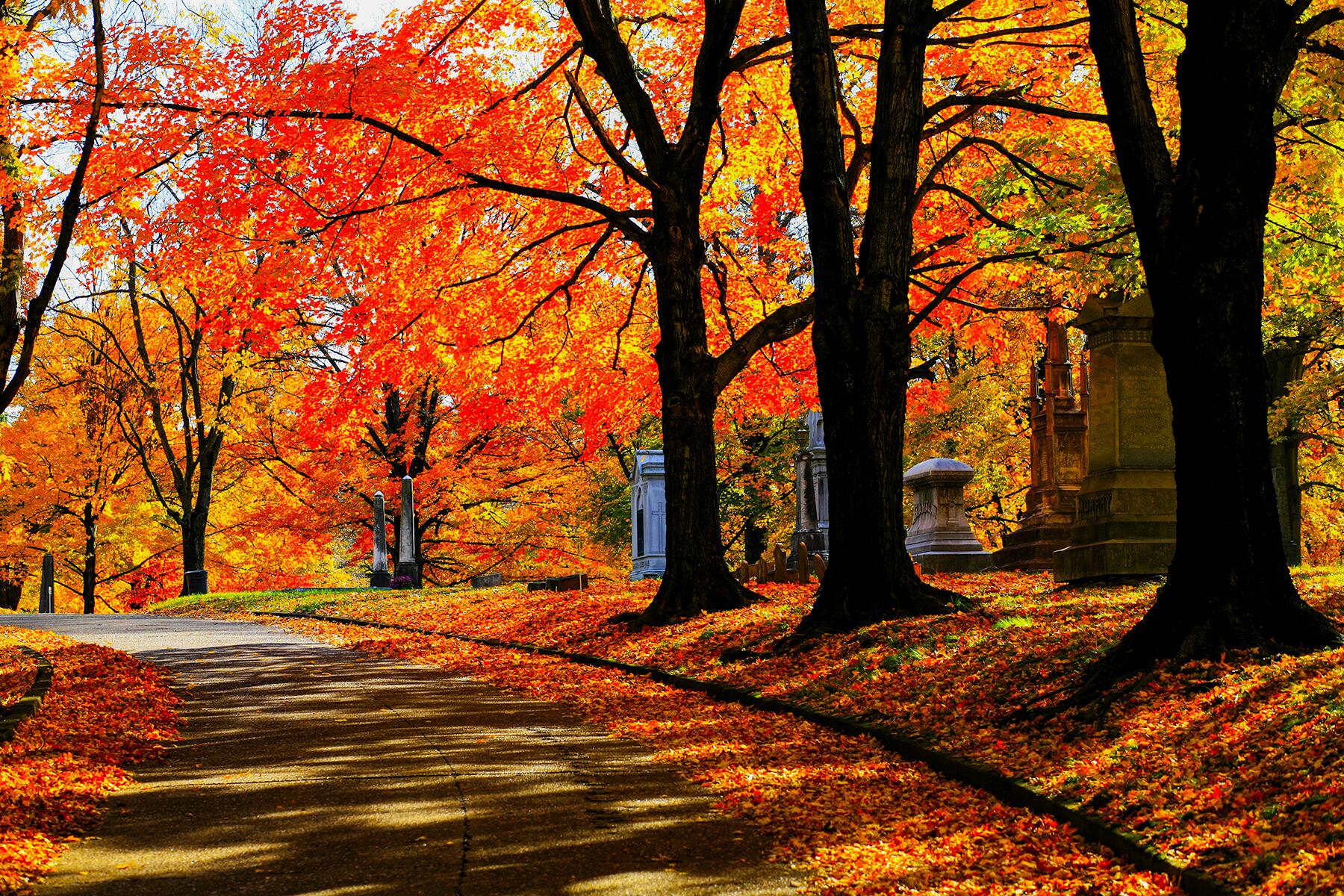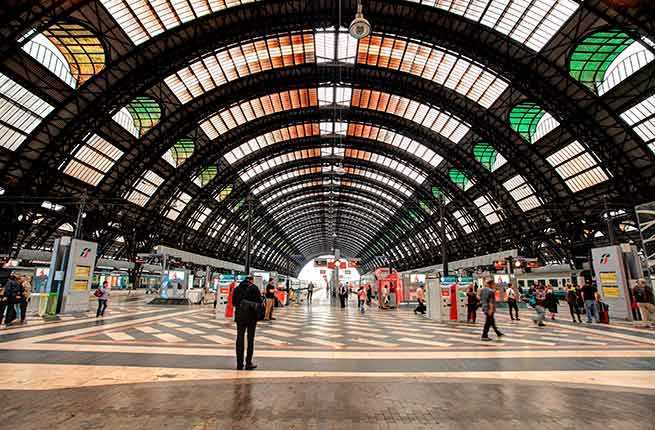
Train travel is not only fast and efficient, but also provides ample opportunity to admire some of the world's greatest architecture. Though now a less used means of transport, train travel was once at the forefront of innovation, revolutionizing travel and prompting monarchs, architects, and city planners to build magnificent train stations to impress passengers. From lavish Beaux-Arts stations to ultra-modern masterpieces, here are 20 beautiful railway stations around the world.
by Laura Itzkowitz
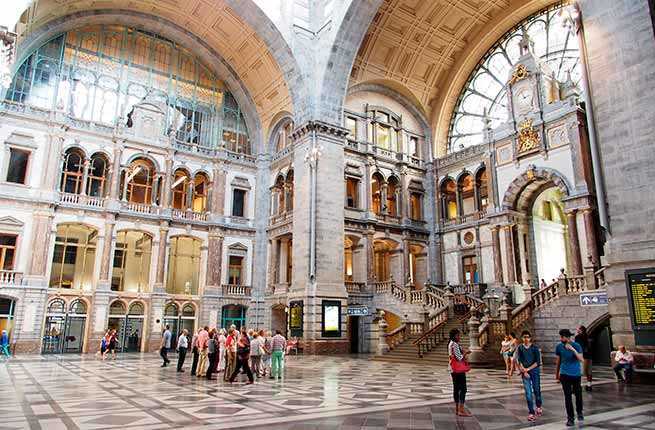
ANTWERP CENTRAAL STATION
Antwerp, Belgium
King Leopold II spared no expense in building the Antwerp Centraal Station at the turn of the 20th century. Completed in 1905, the opulent neo-Baroque station contains more than 20 types of marble and stone. A handsome antique clock marks the time for passengers waiting to catch a train under the iron and glass vaulted ceiling. Though it was originally built as the terminus of the Brussels-Mechelen-Antwerp railway line, the station now functions as a through-station for commuter trains, intercity trains, and Thalys high speed trains connecting Amsterdam to Paris and Lille via Belgium.
Insider Tip: W. G. Sebald's 2001 novel Austerlitz opens in the main hall, where the protagonist muses on the grandiose station.
PLAN YOUR TRIP: Visit Fodor's Antwerp Guide
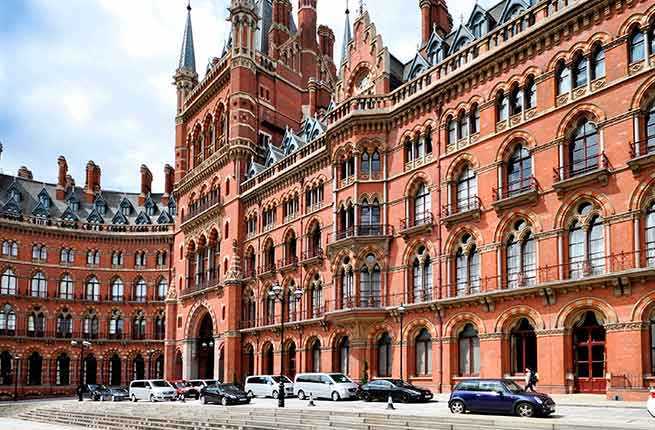
ST. PANCRAS INTERNATIONAL
London
St. Pancras International station’s immense halls greet people arriving in London from all over the UK, France, and Belgium on the Eurostar. The station took 20 years to build, and when it was completed in 1868, it was the largest enclosed space in the world. The red brick Gothic façade remains a testament to England’s great Victorian architecture, even surviving the Blitz during WWII. During the war, it was an important escape route and meeting point for the Allied soldiers.
Insider Tip: St. Pancras boasts many shops, restaurants, and bars, including Searcys Champagne bar.
PLAN YOUR TRIP: Visit Fodor's London Guide
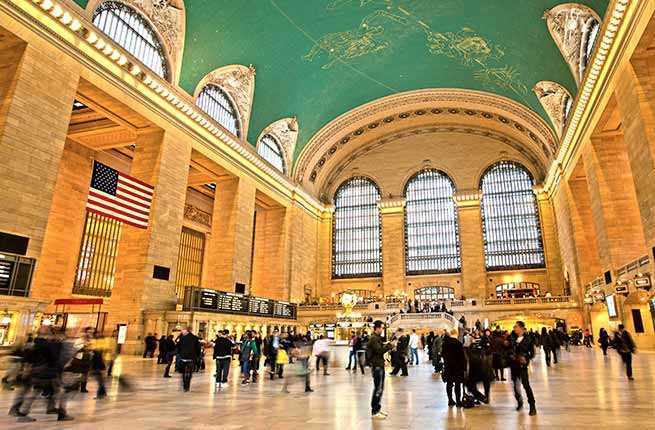
GRAND CENTRAL TERMINAL
New York City
Grand Central Terminal celebrated its centenary last year, and it looks as gorgeous today as it did in 1913. In the main concourse, a celestial ceiling mural hovers above passengers buying tickets at the antique gold-barred ticket windows. Magnificent gold chandeliers proudly display naked bulbs, showing off the power of electricity, which was still relatively new when Cornelius Vanderbilt had the station built. Grand Central is full of secrets, from the Whispering Gallery, which carries sound across the Guastavino-tiled arches, to the hidden bar—originally tycoon John W. Campbell's office—where you can relive the Roaring Twenties. The enormous station—the world's largest—even has tennis courts upstairs.
Insider Tip: On the lower level, there's a food court with plenty of options for a quick meal, but Grand Central's famed Oyster Bar is a destination in its own right.
PLAN YOUR TRIP: Visit Fodor's New York City Guide

GARE DU NORD
Paris
Constructed in the Beaux-Arts style, the impressive Gare du Nord is befitting of the French capital. On the façade, statues personify the major European cities where trains leaving the station end up, with Paris in the center. During the daytime, the sun's rays flood in through the arched windows and skylights, bathing the station in light. With over 190 million people passing through every year, Gare du Nord is Europe's busiest railway station. It connects several subway lines, the RER commuter train, and regional and international trains. It has appeared in many movies, including The Bourne Identity, The Bourne Ultimatum, Amélie, Les Poupées Rousses, and Ocean's Twelve.
Insider Tip: At the Grands Boulevards south of Gare du Nord, you'll find much of the same elegant Haussmannien architecture, especially in the passages couverts, where shops sell everything from the latest fashions to antique prints.
PLAN YOUR TRIP: Visit Fodor's Paris Guide

MILANO CENTRALE
Milan
The grandiose Milano Centrale station that exists today replaced two previous stations. King Victor Emmanuel III laid the cornerstone of the current station in 1906 before the final blueprints were chosen. Its design was modeled on Union Station in Washington, D.C., but became more ambitious and complex under Mussolini. Several architectural styles—mostly Art Deco and Liberty—combine to form the stunning station, which boasts 11,000 cubic meters of marble. About 500 trains pass through every day, carrying passengers from Milan to the rest of Italy and beyond.
Insider Tip: From Milan, it's not far to Genoa and the coastal town of Portofino, one of Italy's most gorgeous seaside towns.
PLAN YOUR TRIP: Visit Fodor's Milan Guide

KUALA LUMPUR RAILWAY STATION
Kuala Lumpur, Malaysia
Eastern and Western architectural styles blend at Kuala Lumpur's gleaming white railway station, forming an eclectic mix. Mughal, Moorish Revival, and Indo-Saracenic elements co-exist in the station designed under British colonial rule and completed in 1910. It was originally the city's main railway hub for the Federated Malayan States Railways and the Malayan Railway, though Kuala Lumpur Sentral Station has occupied that role since 2001. Today, the Kuala Lumpur Railway Station serves commuter trains.
Insider Tip: Don't forget to look up or you'll miss the amazing minaret-style towers.
PLAN YOUR TRIP: Visit Fodor's Kuala Lumpur Guide
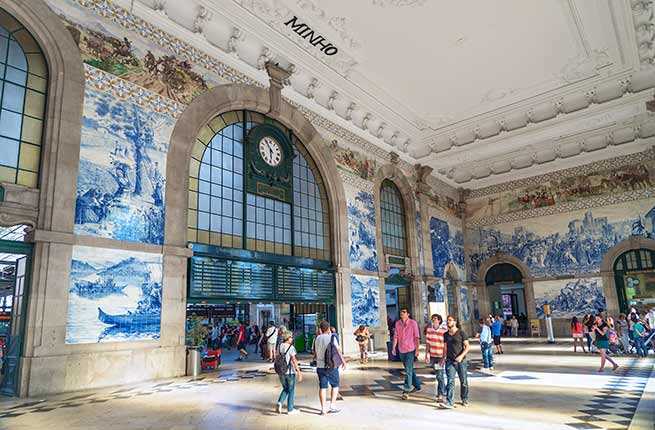
ESTACAO DE SAO BENTO
Porto, Portugal
Occupying the site of the former convent of S. Bento de Avé-Maria, the Estação de São Bento is celebrated for its exquisite blue and white mural depicting scenes from Portugal's history. It took artist Jorge Colaço 14 years to complete the masterpiece made of 20,000 tin-glazed ceramic tiles. The exterior isn't bad either—architect Marques da Silva was inspired by Parisian architecture and included a mansard roof and stone façade in his design.
Insider Tip: From Porto, it's an easy train ride to Coimbra, where you can visit the Biblioteca Joanina, one of most stunning libraries in the world.
PLAN YOUR TRIP: Visit Fodor's Porto Guide
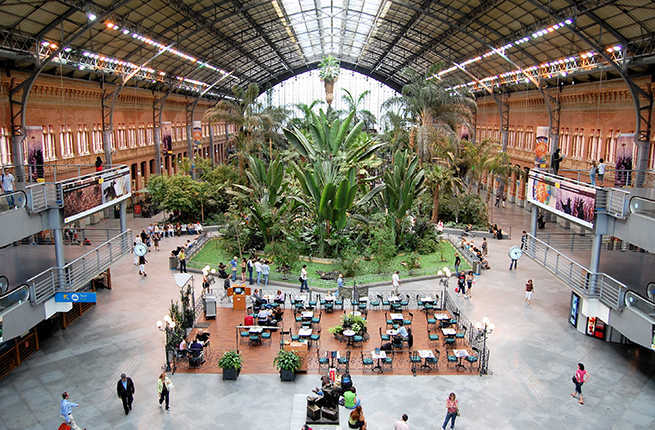
ESTACION DE MADRID ATOCHA
Madrid
A lush tropical garden grows in the main concourse of the Estación de Atocha in Madrid. It was Madrid's first and largest train station, originally inaugurated in 1851. When a fire destroyed the first building, a glorious, wrought iron station designed by Alberto de Palacio Elissagne, with help from Gustave Eiffel, replaced it. In 1992, a more modern terminal was built adjacent, replacing it as a transit hub. Passengers traveling through the new terminal can still pass through Atocha Station, which contains shops, cafés, and a nightclub.
Insider Tip: Be sure to visit the memorial commemorating the victims of the 2004 terrorist bombing inside the station.
PLAN YOUR TRIP: Visit Fodor's Madrid Guide
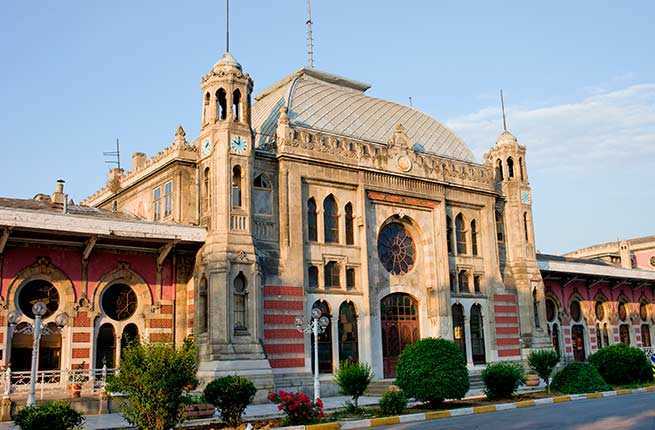
SIRKECI STATION
Istanbul
Inaugurated as the terminus of the Orient Express from Paris in 1890, Sirkeçi Station fuses French Art Nouveau elements and Ottoman architectural details. The 13,000-square-foot station was built with modern (at the time) amenities such as gas heating and lighting. Visitors often admire the stained glass windows on the stone and brick façade. Trains coming into the station pass by Topkapi Palace, one of the world's most spectacular palaces. Though the old entrance is no longer used, trains still pass through the station.
Insider Tip: Relive the famed journey on the Venice-Simplon Orient Express, which uses trains from the 1930s.
PLAN YOUR TRIP: Visit Fodor's Istanbul Guide
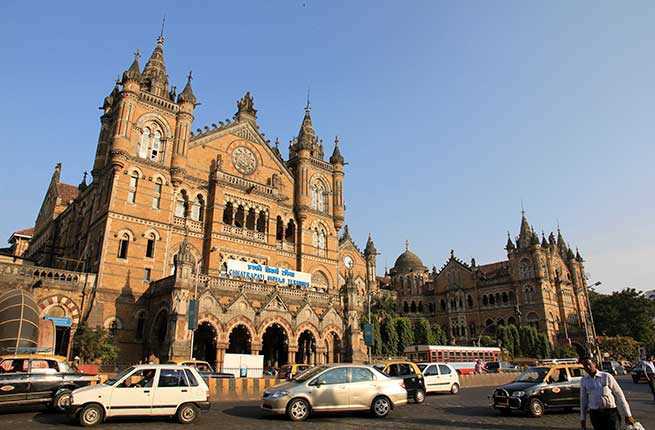
CHHATRAPATI SHIVAJI TERMINUS
Mumbai
The historic Chhatrapati Shivaji Terminus is a UNESCO World Heritage Site and was a symbol of Bombay's prestige. Originally known as Victoria Terminus, it was designed by British architect Frederick William Stevens to honor Queen Victoria, Empress of India. The imposing Victorian Gothic Revival station took 10 years to build and was completed in 1888. A fusion of Western and Eastern styles, it was inspired by St. Pancras as well as Indian palace architecture. Indian craftsmen aided in the construction and sculpted elements to represent the two cultures. Three million commuters pass through the station every day, as it connects Mumbai to the suburbs.
Insider Tip: Among the station's sculpted elements, look for the lion, which represents England, and the tiger, which symbolizes India.
PLAN YOUR TRIP: Visit Fodor's Mumbai Guide
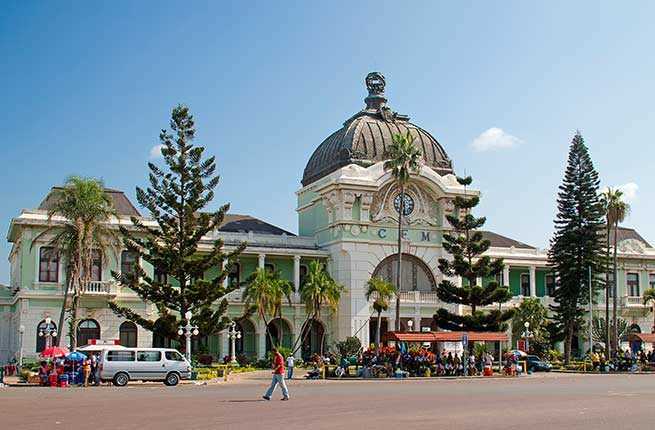
CMF RAILWAY STATION
Maputo, Mozambique
The beautiful CMF Railway Station in Maputo, the capital of Mozambique, is a splendid remnant of Portuguese colonial rule. The white and mint green building with its central dome resembles the work of Gustave Eiffel—though whether he actually worked on the building is contested. A visit to the station feels like taking a trip back in time, as it still has old wooden benches, ticket counters, and antique steam locomotives on display.
Insider Tip: Even if you're not taking a train, it's easy to stop by on your way to the nearby botanical gardens.
PLAN YOUR TRIP: Visit Mozambique Tourism
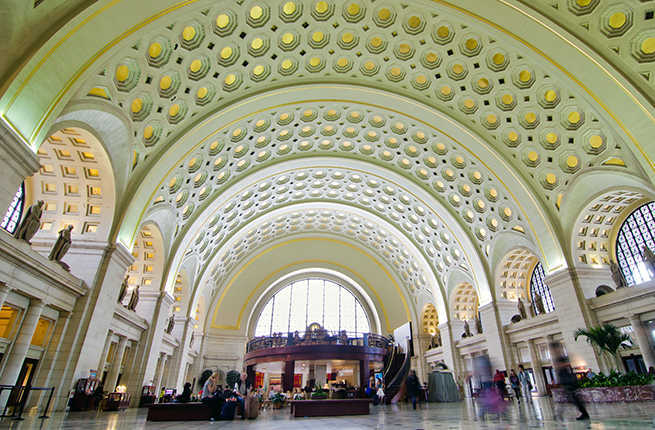
UNION STATION
Washington, D.C.
A masterpiece of Beaux-Arts architecture, Union Station set the precedent for Washington D.C.'s major monuments, including the Lincoln and Jefferson Memorials, the Federal Triangle, the Supreme Court Building, and the National Gallery of Art. It even served as a model for Milan's train station. Daniel H. Burnham—principal architect of the World’s Fair in Chicago—modeled the station on the Baths of Caracalla and Diocletian and the monumental Arch of Rome. In the main hall, the barrel vaulted, white-coffered ceiling makes quite an impression. Outside, the stone façade with its rows of columns and statues looks straight onto the Capitol.
Insider Tip: The station's restored Presidential Suite is shaped like the Oval Office, and the walls—which seem to be made of leather and mahogany—are actually trompe l'oeil.
PLAN YOUR TRIP: Visit Fodor's Washington, D.C. Guide
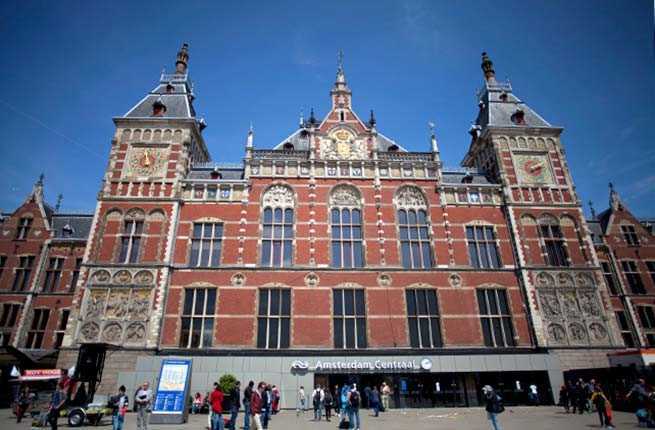
AMSTERDAM CENTRAAL STATION
Amsterdam
The construction of Amsterdam's huge Centraal Station marked the end of the city's seafaring past, as it blocked the view of the waterfront. Engineers had to create three artificial islands and ram 8,600 wooden piles under the foundation to support it. The station was completed in 1889, supplying the main transit hub for the city of canals. The city's Protestant residents originally deemed its Gothic details a bit too Catholic, but today it is considered a fine example of Dutch neo-Renaissance architecture.
Insider Tip: Pierre Cuypers, the station's architect, also designed the Rijksmuseum, which boasts one of the world's most stunning libraries.
PLAN YOUR TRIP: Visit Fodor's Amsterdam Guide
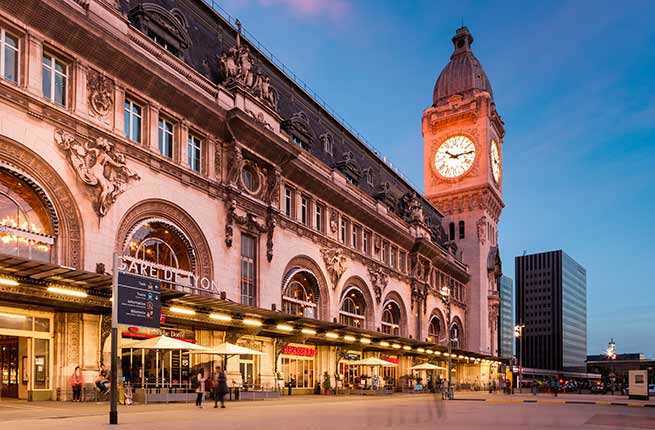
GARE DE LYON
Paris
Commissioned for the World Exposition of 1900, the Gare de Lyon exemplifies the architecture of its time, with its large clock tower, stone façade, glass and iron ceiling, and Beaux-Arts details. Le Train Bleu, the station's opulent restaurant, has been serving guests, including Salvador Dalí, Coco Chanel, Brigitte Bardot, and Jean Cocteau, since 1901. The Gare de Lyon—located in the 12th arrondissement—is the terminus for the Paris-Marseille line. It serves trains headed to the south and east of France, Switzerland, Italy, Germany, and Spain.
Insider Tip: Many of the trains leaving the Gare de Lyon are destined for beautiful train stations in Nice, Monaco, and other towns on the French Riviera.
PLAN YOUR TRIP: Visit Fodor's Paris Guide

HAYDARPASA TERMINAL
Istanbul
The palatial Haydarpasa Terminal is perched on the banks of the Bosphorus in the Kadıköy neighborhood. The site was chosen for the terminus of the Baghdad Railway and the Hejaz Railway in 1904, and the neo-classical building was completed in 1909. The station looks European for a reason—the Anatolian Railway brought on German architects Otto Ritter and Helmut Conu, who employed German and Italian stonemasons to sculpt the impressive building.
Insider Tip: The terminal is currently closed for renovations, along with many historic stations in the region.
PLAN YOUR TRIP: Visit Fodor's Istanbul Guide

DUNEDIN RAILWAY STATION
Dunedin, New Zealand
The picturesque Dunedin Railway Station earned its architect George Troup the nickname “Gingerbread George” and a knighthood from the king. Built in 1906 in a Flemish Renaissance style, the distinctive patterns were created by dark basalt from Kokonga combined with white Oamaru stone. Pink granite accents the design, and a terracotta roof contains shingles from Marseilles. Rounding out the striking décor, stained glass windows of steaming locomotives filter light onto the mosaic floors.
Insider Tip: The station is home to the Sports Hall of Fame, New Zealand's only sports museum.
PLAN YOUR TRIP: Visit Fodor's Dunedin Guide
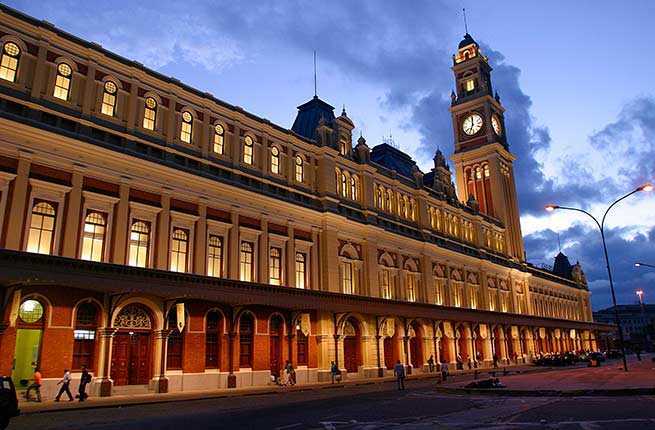
ESTACAO DA LUZ
São Paulo
Created at the end of the 19th century as the main hub for the newly founded São Paulo railway, the Estação da Luz was actually built in Glasgow, disassembled, and then reassembled in São Paulo. At the time, coffee was shipped by railroad, making the station an important throughway for commerce. Though the station was neglected for many years, it was restored in the 1990s and is an important connection for the suburban rail system and the subway.
Insider Tip: The station houses the Museum of the Portuguese Language.
PLAN YOUR TRIP: Visit Fodor's Sao Paulo Guide
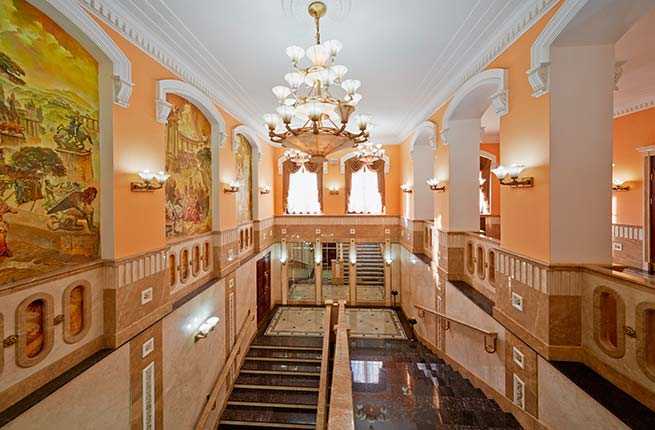
KAZANSKY RAILWAY STATION
Moscow
Train and subway stations in Moscow are surprisingly ornate, and Kazansky Railway Station is no exception. It is the western terminus of the Trans-Siberian Railway and Moscow’s largest train station. Designed by Alexey Shchusev—architect to Tsars and Stalin alike—it was started in 1913 and completed in 1940. Various styles compete for attention—Art Nouveau, details drawn from the Kremlin, and a Rococo interior.
Insider Tip: In the station's restaurant, diners eat under an elaborately decorated ceiling before boarding overnight trains to far-flung destinations.
PLAN YOUR TRIP: Visit Fodor's Moscow Guide

KANAZAWA STATION
Kanazawa, Japan
The ultra-modern entrance to the Kanazawa Station was unveiled in 2005 to mixed reviews, but it has become a much-admired site since. Initially, many felt the modern architecture didn’t represent the historic town, which was miraculously unharmed during WWII and has preserved the former samurai quarters and geisha district. The station's hand-drum-shaped wooden Tsuzumi Gate and glass and steel Motenashi dome have come to stand for the fusion of modern technology with traditional forms. Outside, a futuristic fountain displays the time like a digital clock.
Insider Tip: When in Kanazawa, check out the sleek, modern library included in our list of the world's most stunning libraries.
PLAN YOUR TRIP: Visit Fodor's Kanazawa Guide

LIEGE-GUILLEMINS STATION
Liège, Belgium
Santiago Calatrava's sleek, curvaceous train station in Liège has earned the contemporary architect countless accolades and attracts architecture buffs to this small Belgian city. Made of steel, glass, and white concrete, the station seems to bring the outside in, with light pouring in through the windows and skylights. High-speed trains shuttle passengers off to other parts of Belgium, Germany, France, the Netherlands, and Luxembourg. The main concourse has plenty of shops, cafés, and restaurants, plus a tourist information office and ticket office.
Insider Tip: There's plenty to do in Belgium beyond Brussels, and Liège is a short trip from the capital.
PLAN YOUR TRIP: Visit Fodor's Belgium Guide


